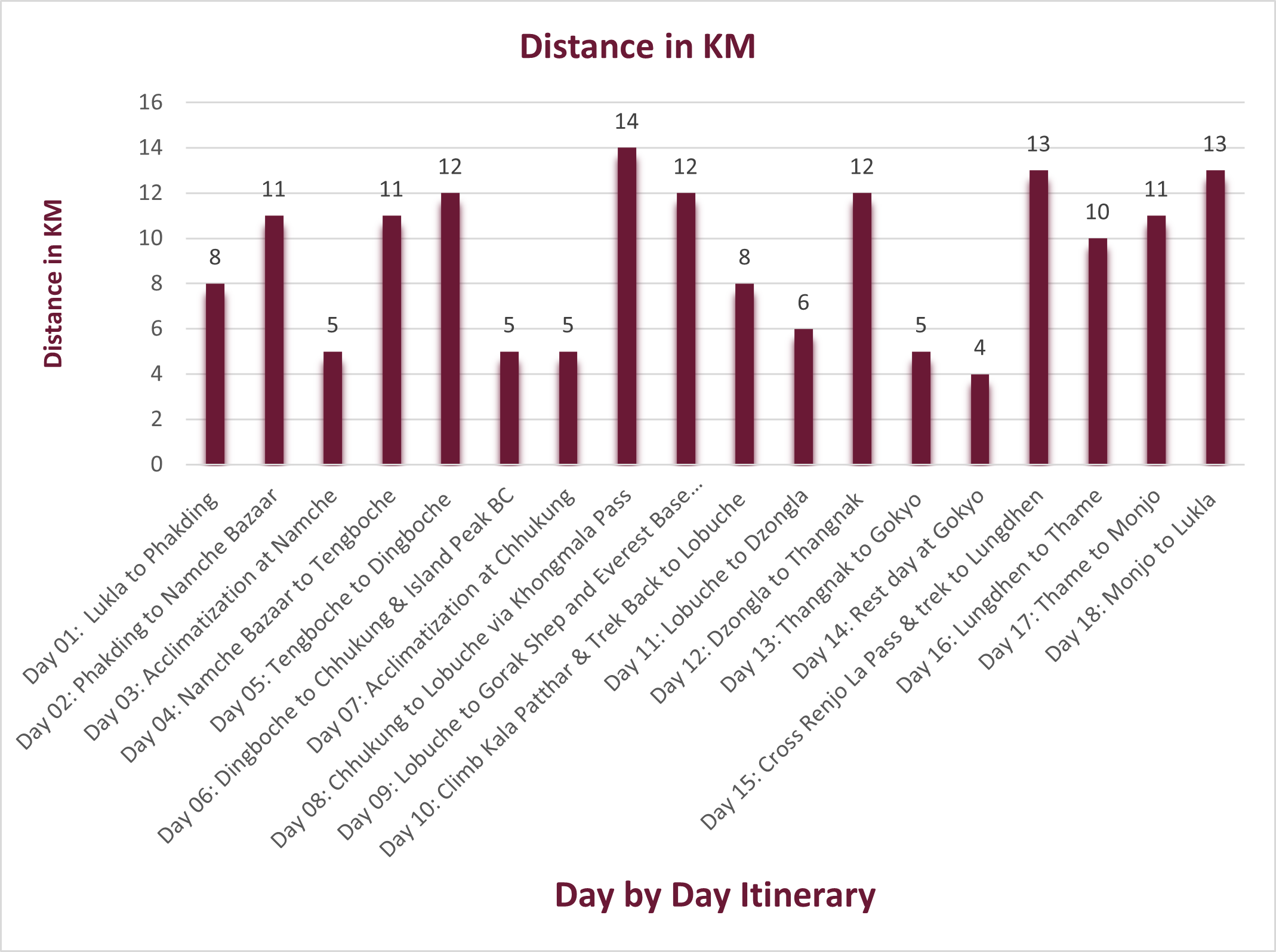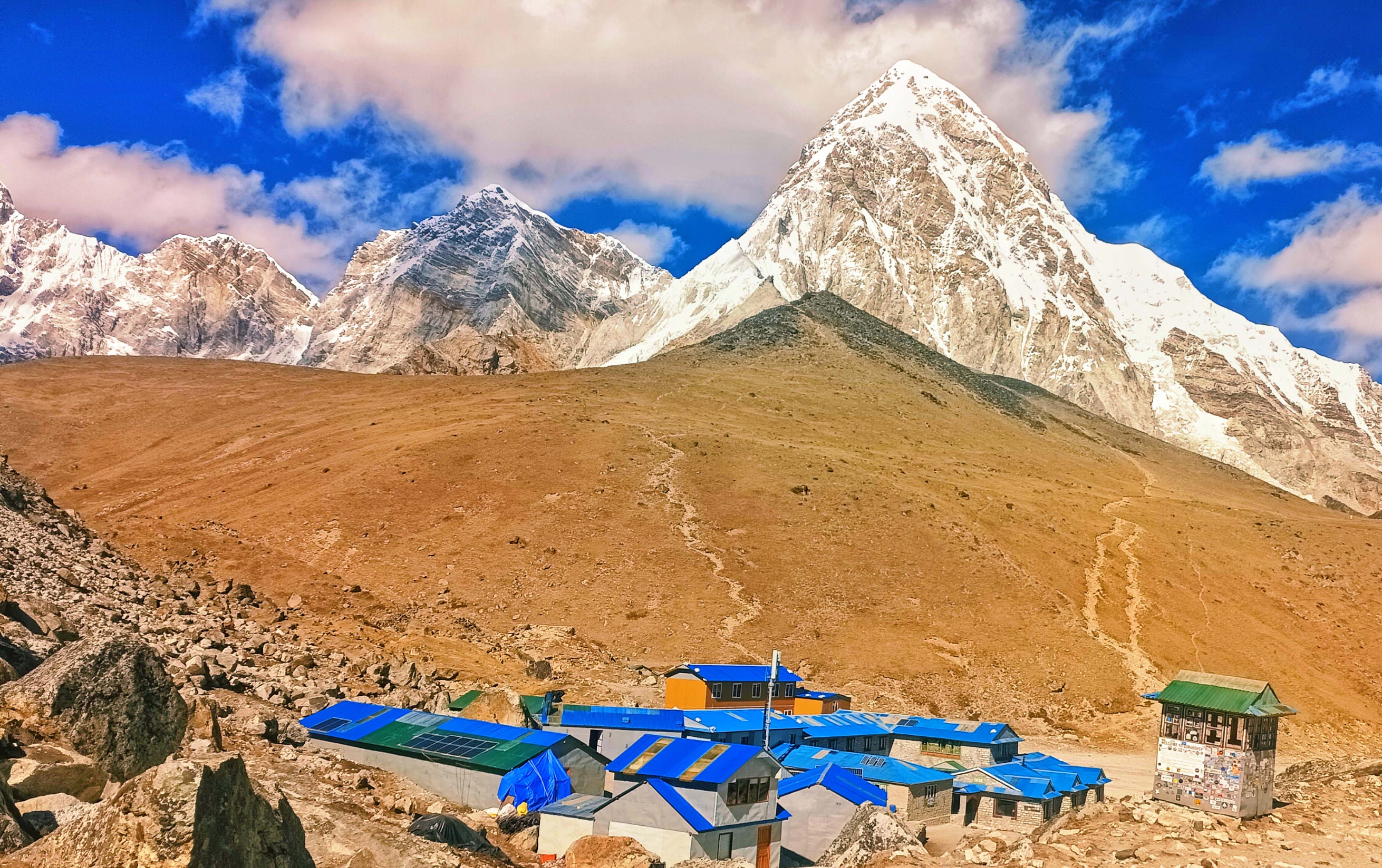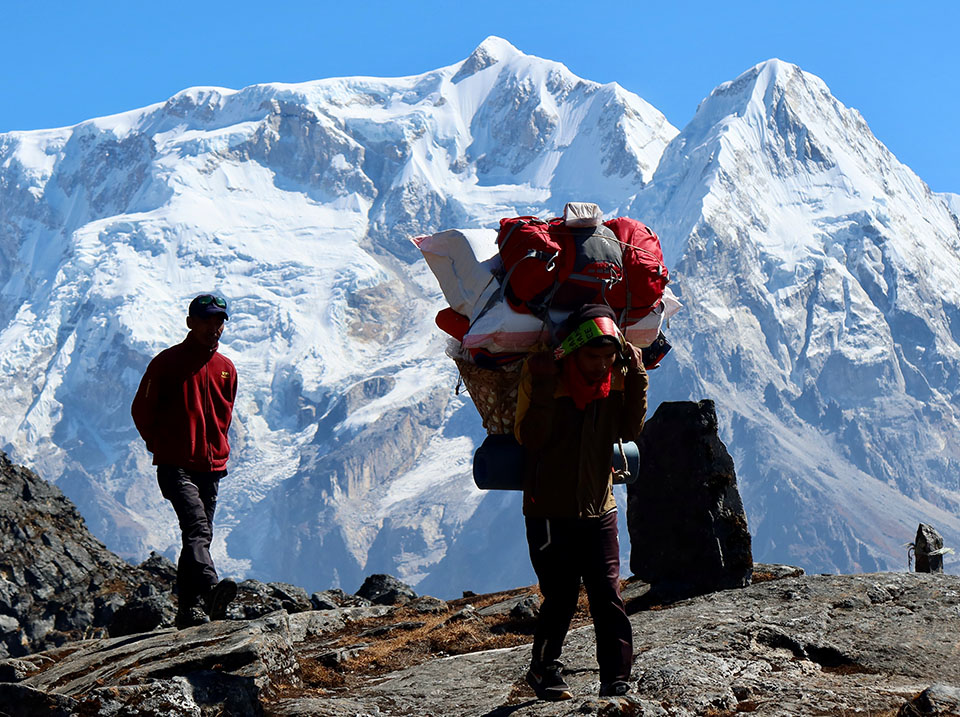Certainly, one of Nepal's most impressive and strenuous trekking expeditions, the Everest Three High Pass Trek links Everest Base Camp to the three legendary high passes: Kongma La (5,535 m), Cho La (5,420 m), and Renjo La (5,360 m). Through varied terrain - from green valleys and pine forests to glacial moraines and snow-covered passes - the trek offers both monumental physical challenge and stunning Himalayan Views. This is very important in planning your pace and acclimatization, plus your daily hiking itineraries.
The trek, approximately 103 miles of 166 kilometres over 18-21 days, takes you across Sherpa villages and high remote monasteries, panoramic viewpoints, and a true off-the-beaten-path experience in the Khumbu region. You have to prepare yourself physically and mentally as day-to-day distances range from short acclimatization hikes and long, strained crossings of high passes. This guidebook describes each stage of the trek so you can see the mileage, elevation gain, and effort required in each segment, enabling you to plan a safe, enjoyable, and unforgettable journey through one of the world's great trekking regions.
1. Introduction:
Why Distance Matters in the Everest Three High Pass Trek
In organizing the Everest Three High Pass Trek, overall distance is as crucial as terrain and elevation. At approximately 166 kilometers (103 miles) over 18–21 days, the trek is a physically demanding experience with extended walking days punctuated by high-altitude treks over Kongma La (5,535 m), Cho La (5,420 m), and Renjo La (5,360 m).
Distance matters because it directly affects daily hike time, acclimatization, expenditure of energy, and overall trek pacing. Compared to the standard Everest Base Camp Trek, this route contains a number of challenging passes, which means more effort for fewer miles but on steeper, higher terrain. Detailed day-to-day mileage planning allows hikers to pace themselves, rest frequently, and enjoy the experience without exhaustion.
The trek also offers a variety of scenery, ranging from low valley thundering rivers and dense forests to alpine meadows, moraines, and snowy passes.
2. Overview of the Everest Three High Pass Trek Distance
- Total Distance for Trekking: Approx. 166 km / 103 miles
- Starting Point: Lukla (2,860 m)
- Ending Point: Lukla (return trip) or Kathmandu (in case of flying out)
- Highest Trek Point: Kongma La Pass – 5,535 meters (18,159 ft)
- Average Distance per Day: 8–12 km per day, with high-pass days being 18–20 km
- Total Days: 18–21 days (with acclimatization days included)
The average daily distance may look moderate, but the challenge of the hike is in altitude, boulder-strewn terrain, and longer days over the passes. Acclimatization days at Namche and Dingboche are subtly woven into the itinerary to prepare trekkers for high-altitude traversals without sacrificing safety, but with the greatest possible enjoyment of the grand views. This overview gives trekkers a clear concept of what they are getting into and allows them to map their pace, endurance, and preparedness for the undertaking.

The sunset view from the Gokyo Ri viewpoint during the trek to the Everest Three High Pass is breathtaking.
3. Best Highlights of the Everest Three High Pass Trek Route
- Hike Three Legendary High Passes: Kongma La (5,535 m), Cho La (5,420 m), and Renjo La (5,360 m) amidst breathtaking Himalayan scenery.
- Scenic Mountain Views: Watch out for Everest, Lhotse, Nuptse, Ama Dablam, and Cho Oyu from Viewpoints along the trek.
- Sherpa Villages & Culture: Experience traditional Sherpa culture at Namche Bazaar, Dingboche, Pangboche, and Lobuche.
- Alpine Meadows and Glacial Valleys: Hike through the valley of Khumbu, pine forests, and high-altitude moraines.
- Visit Tengboche Monastery, Pangboche Monastery, and other cultural attractions on the route.
- Everest Base Camp Excursion: Pass over the famous Everest Base Camp (5,364 m) along the trekking route.
- Exciting Suspension Bridges & River Crossings: Cross spine-tingling Himalayan suspension bridges over roaring glacial streams.
- Wildlife Encounters: Chance to see Himalayan tahr, snow leopard tracks, and colorful Himalayan birds.
- Off-the-beaten-path, Less Touristy Trekking Experience: Less tourists than on the standard Everest Base Camp trek, with a serene Himalayan experience.
- Teahouse Accommodation: Comfortable local lodges along the trail, with towering mountains in view from your window.
4. Total Daily Trekking Distance of the Everest Three High Pass Trek

Everest Three High Pass Distance Chart.
Day 01: Arrive at Kathmandu.
- Distance: 0 km (first day of Nepal)
- Familiar with Nepalese Culture.
Day 02: Take a flight to Lukla.
- Distance: 0 km (flight day)
- Scenic flight from Kathmandu to Lukla, orientation to the Khumbu region.
# Lukla to Phakding.
- Distance: Approximately 8 km
- Easy trek along the Dudh Koshi River through pine woods and small Sherpa villages.
Day 03: Phakding to Namche Bazaar.
- Distance: Approximately 11 km
- Gradual ascent with suspension bridges and entrance into Sagarmatha National Park; first glimpse of Everest from Topdanda Viewpoints.
Day 04: Acclimatization Day at Namche Bazaar.
- Distance: Short local trekking (~5 km)
- Optional excursion to Everest View Hotel or villages around for acclimatization and cultural insight.
Day 05: Namche Bazaar to Tengboche.
- Distance: About 11 km
- Moderate ascent to Tengboche Monastery with panoramic views of Ama Dablam and Everest.
Day 06: Tengboche to Dingboche.
- Distance: Approx. 12 km
- Gradual climb through Rhododendron forests and river gorges, into high-altitude terrain.
Day 07 Dingboche to Chhukung.
- Gradually climb above the valley of Dingboche and reach Chhukung.
Day 08: Acclimatization Day at Chhukung.
- Distance: Short hikes (~4–6 km)
- Hike to Chhukung Ri or Optional visit the Island Peak Base Camp and Back.
Day 09: Chhukung to Lobuche.
- Distance: Approx. 14 km
- Strenuous climb up to Khongmla Pass, and down to Khumbu Glacier, and walk over the glacier.
Day 10: Lobuche to Gorak Shep and Everest Base Camp.
- Distance: Approx. 12 km
- Gorak Shep trek, then to Everest Base Camp and back; long but fine day.
Day 11: Gorak Shep to Kalaphattar - Lobuche.
- Distance: Approximately 8 km
- Early wake for Sunrise view from Kalaphattar and head down to Lobuche.
Day 12: Lobuche to Dzongla.
- Distance: Approximately 6 km
- Hike along glacial valleys to Cho La Base Camp, preparation for the next high pass.
Day 13: Dzongla to Thangnak via Chola Pass.
- Approx. distance: 12 km
- Challenging climb and descent over Cho La Pass (5,420 m), with breathtaking Himalayan views.
Day 14: Thangnak to Gokyo.
- Approx. distance: 5 km
- Walk over the Ngazumba glacier and enjoy the serene view of the 360 high mountains.
Day 15: Acclimatization Day at Gokyo.
- Distance: Short hikes, Approx (~5 km)
- Hike to Gokyo Ri or Optional visit the 4th lake and back.
Day 16: Gokyo to Lungdhen via Renjo La Pass.
- Distance: Approx. 13 km
- Ascent on slope to Renjo La Base and cross over the pass (5,360 m) with great views of Gokyo Lakes.
Day 17: Lungdhen to Thame.
- Distance: Approx. 10 km
- Long downhill through high-altitude valleys back into central Khumbu villages.
Day 18: Thame to Monjo.
- Distance: Approx. 11 km
- Walk Pass by Namche Bazaar and down to Larga bridge and exit Sagarmatha Nationl Park.
Day 19: Monjo to Lukla.
- Distance: Approx. 13 km
- Final trek along Dudh Koshi River, completing the three high passes.
Day 20: Fly from Lukla to Kathmandu.
- Distance: 0 km (flight day)
- Scenic return flight with bird's eye views of Everest and surrounding peaks.
Day 21: Free Day in Kathmandu.
Day 22: Final Departure to your home country and see off!

Mt.Pumori 7,161 meters, and Gotrekshep 5180 meters.
5. How Difficult Is the Trek in Terms of Distance?
While the Everest Three High Pass Trek averages 8–12 km per day, the difficulty lies in its altitude, terrain, and quantity of high passes. Each day involves steady walking on uneven terrain like rocky trails, glacial moraines, and some snow-covered paths. High-pass days like Kongma La, Cho La, and Renjo La can be as much as 15–18 km, with 8–10 hours of walking involving steep ascents and descents.
Altitude gain is one of the biggest elements of challenge. Trekkers start from Lukla (2,860 m) and go over 5,500 meters at Kongma La, demanding proper acclimatization to prevent altitude sickness. The trek has strategic rest and acclimatization days in Namche Bazaar, Dingboche, and Gorak Shep, so the body slowly adjusts to thinner air.
Despite moderate daily distances, the high passes, changing terrain, and long days all add up to make this trek moderately strenuous to strenuous. It is suitable for fit beginners with a little trekking experience and all intermediate trekkers if they maintain a steady pace, stay well hydrated, and take advice from experienced Everest region guides.
Frequently Asked Questions about the Everest Three High Pass Trek Distance
1. What is the distance of the Everest Three High Pass Trek?
The trek is approximately 166 km (103 miles) from Lukla and back, incorporating the three high passes: Kongma La, Cho La, and Renjo La.
2. How many days does it usually take?
Usually 18–21 days, incorporating acclimatization days at Namche Bazaar, Dingboche, and Gorak Shep to safely acclimatize to altitude.
3. What day has the longest walking distance?
The most demanding day is the Kongma La or Cho La pass, which is 15–18 km and 8–10 hours of trekking on high passes.
4. Is the trek recommended for beginners?
Though daily distances are modest, the high altitude and high-pass crossing make it moderate to strenuous. Physically fit beginners can do it with proper training, acclimatization, and a skilled guide.
5. What is the daily average distance?
Most days are 8–12 km, and high-pass days are up to 18 km. Trekking hours are 5–10 hours, depending on terrain and altitude.
6. Can the total distance be shortened?
Yes. Some sections, like Lukla to Namche or Gokyo loops, can be skipped by jeep or helicopter, reducing overall trekking distance. Please contact Visit Himalaya Treks for custom arrangements.
7. Is the distance inclusive of acclimatization hikes?
Yes, rest days at Namche Bazaar, Dingboche, and Gorak Shep entail optional short hikes, which are factored into the total distance.
8. How much altitude is gained on the trek?
Trekkers start at 2,860 m (Lukla) and ascend to 5,535 m (Kongma La), with incremental increases along the trek to help with acclimatization.
9. What kind of terrain will I traverse?
The trek passes through forests, river valleys, alpine meadows, glacial moraines, and snow-covered passes, providing diverse and demanding trekking terrain.
10. How do I train to complete the distance safely?
Train with cardio, uphill hiking, backpack training, and strength training. Hydration, good pacing, and guidance from Visit Himalaya Treks staff make you complete the distance safely and enjoyably.








